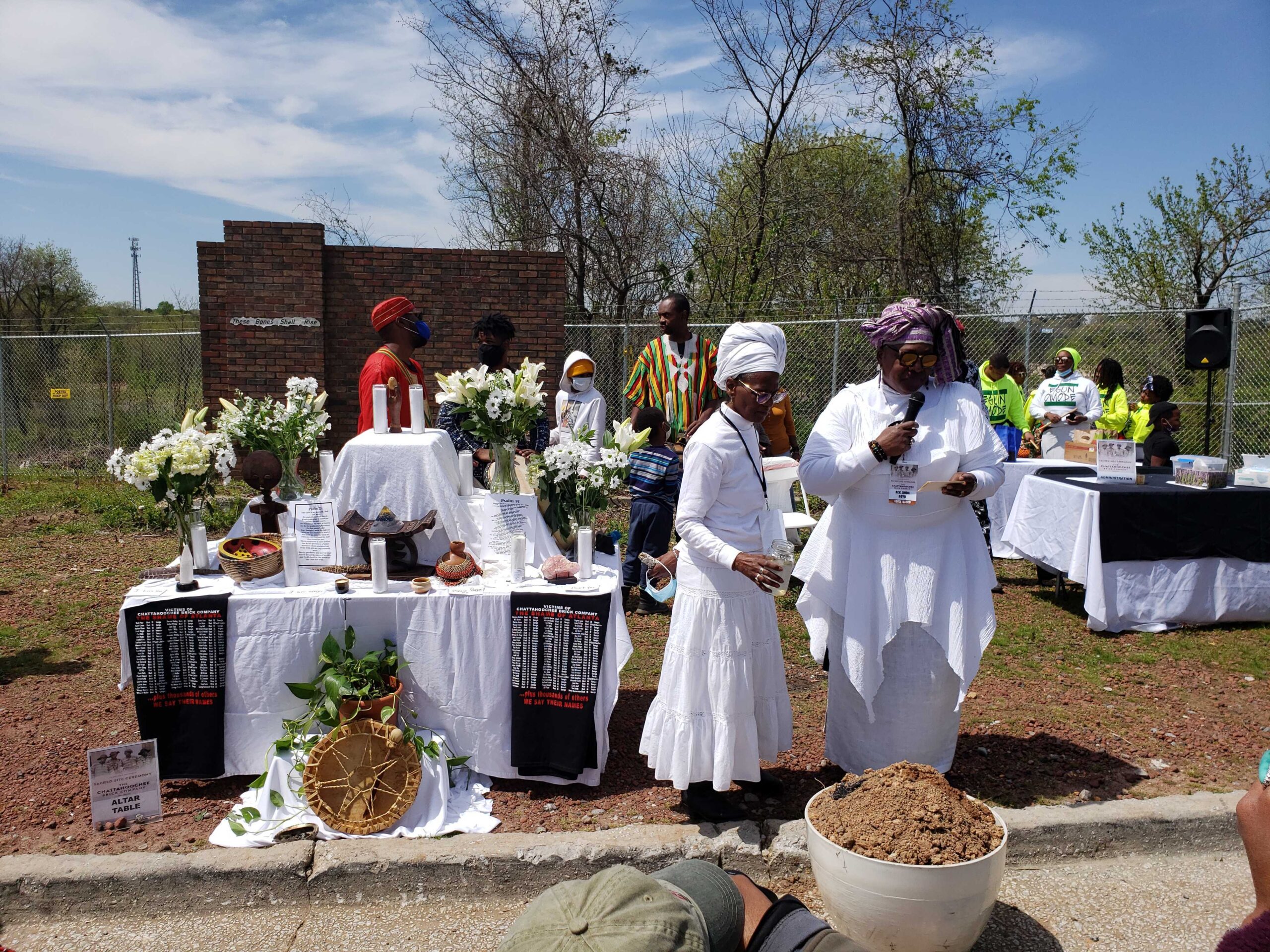Black community leaders are hopeful they may be making progress in a fight to reclaim land in northwest Atlanta that they say is sacred.
Clergy, activists, lawmakers and members of the community held a consecration ceremony at the site of the old Chattahoochee Brick Co. this past weekend to memorialize the victims of the atrocity that took place there.
They hope to one day have a permanent memorial on the land.
For now, it’s a mostly bare, partially excavated dirt plot, surrounded by chain-link fencing, directly beside the train tracks. There is little sign of the documented brutality that took place there in the early 20th century or the many bodies some believe to be buried there.
“I have been on the property when the gates and fences are not up. I can tell you, if you get quiet enough and you stand still enough, you will feel the souls of those people,” said Donna Stephens, an activist who spoke at Saturday’s event.
‘As Close To A Picture Of Hell’
It was a place where Black people were forced to work and died long after the Emancipation Proclamation.
The brick company was one of many convict labor camps in the post-Civil War South, where Black men, women and children were sold into captivity, many after being arrested on made-up charges.
Some historians have described the convict-lease system as having been worse than slavery because the owners of these camps paid so little for each person that they had little incentive to keep them alive rather than work them into the ground and replace them.
Conditions in the camp were brutal, and the mortality rate was extremely high.
“If you had been here 120 years ago, standing in this same place, what you would have seen would have been as close to a picture of hell as you could ever imagine,” said Douglas Blackmon, Pulitzer Prize-winning author of a book and documentary on the subject, “Slavery by Another Name.”
“Literally, fire and smoke and the screams of men. There were sworn stories from that time that people could hear the screams a mile away from here,” Blackmon said during Saturday’s ceremony.
Chattahoochee Brick was owned by James English, a former mayor of Atlanta and captain in the Confederate Army. Many of the bricks produced there went to pave the roads and rebuild houses after Atlanta was burned down during the Civil War.
‘The Drills Are Stopped Now Because of You’
Some of the activists involved have been fighting for years and have watched as the site of the former brick company has changed hands between corporate owners without the historical recognition that community members desire.
Norfolk Southern railroad, which is in the process of relocating its headquarters to Atlanta, has train tracks that run directly adjacent to the land, and earlier this year, they leased the property to build a fuel terminal.
The project was canceled after protests and demonstrations led the city of Atlanta to file a petition with the federal agency that oversees railroads.
The Rev. Timothy McDonald of the First Iconium Baptist Church recognized the organizers whose efforts stopped the industrial development.
“There was no fencing when we first came here. They thought that was going to keep us out — that has not happened,” McDonald said. “The trucks are gone now, the drills are stopped now because of you. Our ancestors are able to rest because of people like you.”
McDonald said he does not believe a study done by Norfolk Southern that failed to find human remains on the land.
“We are certain from research and from ancient plats that there are graveyards, at least two on this site, where Black men, in particular, worked here, died here and were buried here,” McDonald said.
Donna Stephens is an environmental activist who lives in a nearby neighborhood named for James English. She leads the Descendants of Chattahoochee Brick Co. Coalition and has been advocating since the beginning for the site to be used in a way that benefits the neighborhood and honors the dead.
“Because they didn’t have a funeral. And today, we give them a memorial service. And we’re going to fight until we give them a proper memorial,” Stephens said.
Stephens is also concerned about the environmental impact of having more industrial development in an area she said is already heavily industrialized with two nearby water systems.
“Proctor Creek is already a compromised water system, the Chattahoochee is already a compromised water system. Why would you want to put more pollutants in the air, water and soil?” Stephens asked.
Stephens is also co-chair of the Proctor Creek Stewardship Council.
Next Steps
Organizers say they are grateful to the city of Atlanta for stopping the development, but now they want the land permanently preserved and memorialized.
Radio host and former Atlanta City Councilman Derrick Boazman has also been involved with the issue for years and has helped organize previous events on the property.
“We want this property bought, acquired, however the city has to do it. And we don’t want to wait to next week, next month or next year — we want it done now,” Boazman said. “We want you to do for this property what you do for the BeltLine, for the Gulch, for all of those places white folks want — we want you to do for our people.”
City Council President Felicia Moore became aware of the issue when representing the district where Chattahoochee Brick is located and has supported the movement to turn the property into a memorial.
“I think that the city certainly can play a role, and I also would like to look at some of the companies that benefited from this property,” Moore said, “and ask them in their social and civic responsibility to help the city purchase this property, and ultimately turn it into something that will memorialize the things that happened here and the people who suffered.”
The land is privately owned for now by Lincoln Terminal, but organizers hope there can be a conversation between the owners, the city and the community about how it can be turned into a permanent memorial and possibly a green space for the neighborhood.









